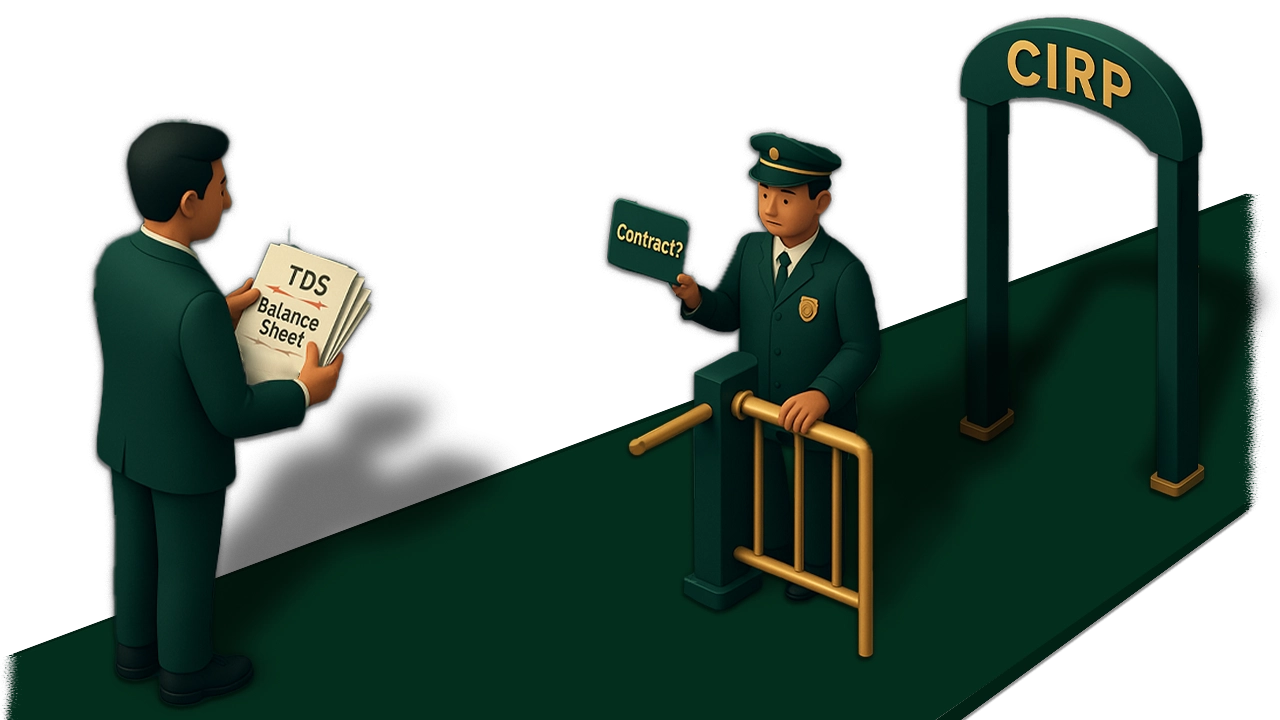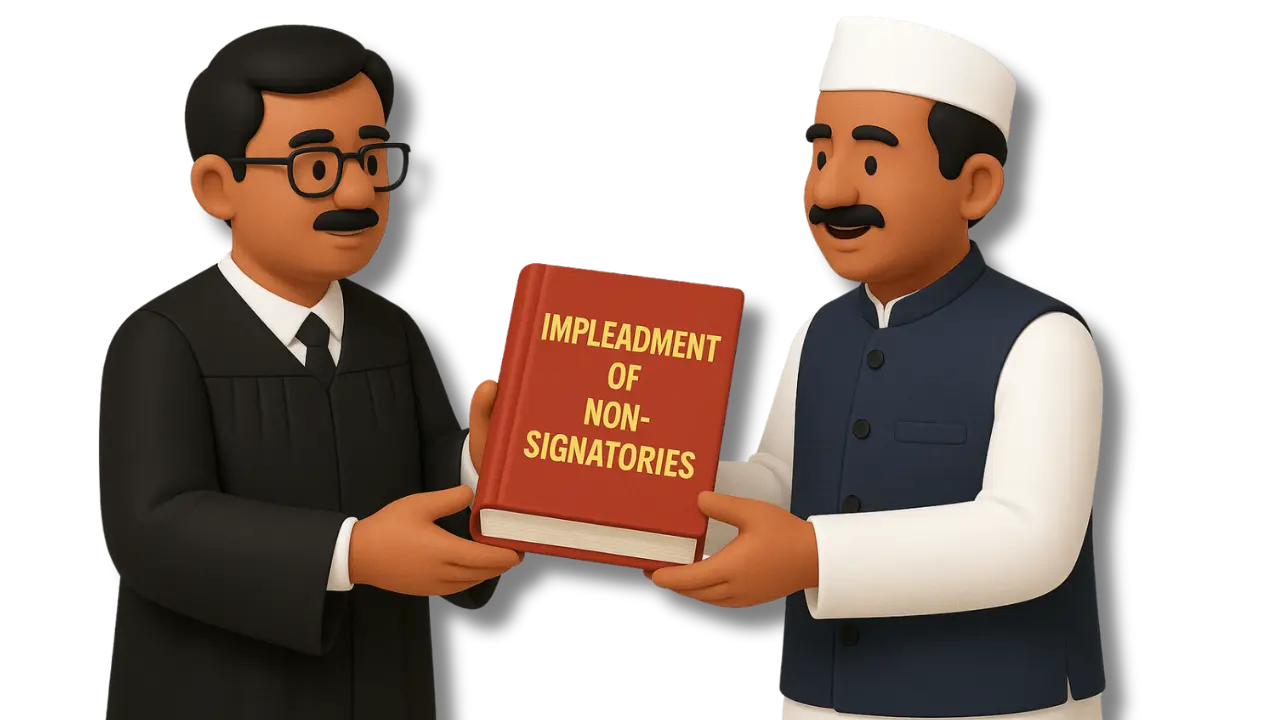Introduction
In the complex landscape of corporate insolvency, a creditor often finds themselves at a crossroads, pondering the evidentiary thresholds required to prove a financial debt and initiate insolvency proceedings. The question of whether a formal, written contract is an absolute prerequisite has been a recurring point of contention. While conventional wisdom often posits that a meticulously drafted agreement is the cornerstone of such a claim, the NCLAT1 has recently offered a significant clarification that challenges this rigid interpretation.
In a landmark decision, the NCLAT New Delhi bench, comprising Justice Rakesh Kumar Jain, Justice Mohd Faiz Alam Khan, and Mr. Naresh Salecha (Technical Member) in Bijendra Prasad Mishra Versus M/s HS Mercantile Pvt. Ltd2., unequivocally held that a written contract is not a precondition for proving the existence of a legally payable debt. The tribunal asserted that the presence of other documentary evidence, as listed under Regulation 8(2) of the CIRP Regulations3, is sufficient to establish the debt and justify the admission of an insolvency application.
This ruling emanated from an appeal filed under Section 61 of the IBC4, challenging an order from the NCLT Kolkata. The core issue before the NCLAT was whether the NCLT5 had erred by admitting an application under Section 7 of the IBC, despite the absence of a formal financial contract. The appellant, the corporate debtor, argued that the adjudicating authority had overstepped its mandate and failed to acknowledge the lack of a formal loan agreement or any other relevant documents. Conversely, the respondent, the financial creditor, maintained that the corporate debtor’s own admissions, coupled with concrete evidence like the payment of TDS6 on interest and the reflection of the debt in its financial statements, irrefutably proved the existence of the financial debt.
This article will delve into the underlying jurisprudence that formed the backbone of this pivotal decision. It will explore how the tribunal, through a meticulous examination of circumstantial and documentary evidence, constructed a compelling case for the existence of a financial debt, thereby setting a crucial precedent that will undoubtedly shape the future of insolvency jurisprudence in India.
The journey begins with the landmark judgment of Innoventive Industries Limited v. ICICI Bank7, where the Hon’ble Supreme Court established a clear, two-pronged test for admitting a Section 7 application. The Adjudicating Authority must only determine whether a default has occurred on a legally payable debt and if the application is within the limitation period. This foundational principle simplified the inquiry, “shifting the focus from the nature of the transaction to the mere existence of a debt and default”.
So, how is the existence of a debt actually proven? The answer is elegantly laid out in the legal framework itself. The IBC, along with the IBBI Regulations, offers a flexible, not prescriptive, approach. Regulation 8(2) is particularly illuminating, using the word “or” to signify that a financial debt can be evidenced by a range of documents. This includes, but is not limited to, records from an information utility, an order of a court or tribunal, or, most notably, other relevant documents like financial statements showing that the debt has not been paid.
This flexibility has been consistently upheld and expanded upon by the National Company Law Appellate Tribunal (NCLAT). In Agarwal Polysacks Limited vs K.K. Agro Foods and Storage Limited8, a coordinate bench explicitly addressed this very issue, holding that a written financial contract is not an exclusive requirement. The court reasoned that a plain reading of Regulation 8(2) makes it clear that a financial contract is just one of several ways to prove a debt, not the only one. This ruling was a culmination of earlier decisions, including Prayag Polytech Pvt. Ltd. vs. Gem Batteries Pvt. Ltd9. and Jagdambey International vs. Visa Powertech Pvt. Ltd10., solidifying the principle that the substance of the transaction, rather than its form, is what truly matters.
Further reinforcing this jurisprudence, the NCLAT, in Satish Balan v. Mrs. Neeta Navin Nagda11, unequivocally stated that the Code does not mandate a written agreement. The presence of acknowledgments by the Corporate Debtor and entries in their statements of accounts, particularly concerning the disbursement of the loan and payment of interest, were deemed sufficient. The tribunal highlighted the significance of the deduction of TDS on interest payments, noting it as a powerful piece of evidence that leaves no room for doubt about the nature of the transaction.
In a similar vein, the NCLAT’s decision in Desana Impex Limited vs. Brick and Mortar Realty Private Limited12 addressed the intriguing interplay between the IBC and other regulations, such as the RBI’s Master Circular on Fair Practices Code. The court held that the IBC, with its overriding effect under Section 238, takes precedence over other laws. It concluded that the lack of a written record cannot, in itself, be a barrier to establishing a debt and a default. The tribunal’s observation that a loan recorded in a balance sheet, even if misclassified as “other liabilities,” still points to the existence of a debt, underscores the judicial tendency to look past technicalities to the commercial reality of a transaction.
The principle has been reiterated in cases like Jaiprakash Agarwal Managing Director13, Bazargaon Paper & Pulp Mills Pvt. Ltd. Vs Alka Prakash Agarwal and Rahul H. Mehta vs Gajendra Investment Ltd14. These decisions collectively affirm that financial debt can be proven through a variety of “other relevant documents.” An acknowledgment of the debt in the corporate debtor’s balance sheet, coupled with supporting documents like TDS deduction certificates, provides a robust basis for a claim.
The question then shifts from “Do you have a contract?” to a more nuanced inquiry: “Can you prove, through any credible documentation, that a debt exists and has not been paid?” The NCLAT’s consistent stance is a resounding “yes.” The focus is on the commercial reality—a disbursement of money against the time value of money, as evidenced by interest payments, balance sheet entries, and acknowledgments—rather than the presence or absence of a formal contract. This jurisprudential shift acknowledges the practicalities of business dealings and ensures that a corporate debtor cannot escape their obligations by merely pointing to the lack of a single, all-encompassing document.
Conclusion
This legal journey, which began with the question of whether a written contract is a prerequisite for proving a financial debt, has culminated in a profound shift in insolvency jurisprudence. The consistent rulings by the NCLAT have not only clarified the law but have also placed a greater emphasis on the commercial substance of a transaction over its formal structure. By validating alternative forms of evidence like balance sheet entries and TDS certificates, the courts have ensured that justice is not hindered by the absence of a single document. This approach recognizes the diverse nature of commercial dealings in India, where informal arrangements and mutual trust often form the basis of financial transactions. It is a testament to the legal system’s adaptability, moving away from a rigid, formalistic interpretation to one that is more aligned with the realities of the business world.
Looking ahead, this jurisprudential development has significant implications for both financial creditors and corporate debtors. For creditors, it simplifies the process of initiating CIRP, empowering them to pursue their claims with a broader range of evidence, thereby improving the efficiency and effectiveness of the insolvency process. For corporate debtors, it serves as a powerful reminder of the importance of clear and accurate financial record-keeping. The days of denying a debt simply because there is no formal agreement are over. Acknowledging a debt in a balance sheet or paying interest—even in an informal capacity—can now be a sufficient basis for a legal claim. This paradigm shift will likely lead to more transparency in corporate financial disclosures and a greater sense of accountability among companies.
As the law continues to evolve, new questions will inevitably arise. Will the courts now have to determine the “weight” of different types of evidence? How will they balance an acknowledgment in a balance sheet against a corporate debtor’s claim that the funds were for a different purpose? For instance, what happens when a company acknowledges an amount in its books but claims it was for a material advance, as opposed to a loan? Furthermore, what constitutes a “legally payable debt” when the evidence is fragmented and circumstantial? The future of insolvency jurisprudence will likely be shaped by these very questions, pushing the boundaries of evidentiary standards and ensuring that the letter of the law remains in service of its true spirit: the timely and effective resolution of insolvency.
Citations
- National Company Law Appellate Tribunal
- Bijendra Prasad Mishra Versus M/s HS Mercantile Pvt. Ltd.Company Appeal (AT) (Ins) No. 2364 of 2024
- Insolvency Resolution Process for Corporate Persons) Regulations, 2016
- Insolvency and Bankruptcy Code, 2016
- National Company Law Tribunal
- Tax Deducted at Source
- Innoventive Industries Limited v. ICICI Bank (2018) 1 SCC 407
- Agarwal Polysacks Limited vs K.K. Agro Foods and Storage Limited, 2023 SCC Online NCLAT 624
- Prayag Polytech Pvt. Ltd. vs. Gem Batteries Pvt. Ltd.”, “Company Appeal (AT) (Ins.) No. 468 of 2019, Jagdambey International
- Jagdambey International vs. Visa Powertech Pvt. Ltd.”, “Company Appeal (AT) (CH) (Ins.) No. 108 of 2023
- Satish Balan v. Mrs. Neeta Navin Nagda, Company Appeal (AT) (Ins.) No. 718 of 2023
- Desana Impex Limitedvs.Brick and Mortar Realty Private Limited, Company Appeal (AT) (Insolvency) No. 318 of 2024
- Jaiprakash Agarwal Managing Director, Bazargaon Paper & Pulp Company Appeal (AT) (Insolvency) No. 292 of 2023
- Rahul H. Mehta vs Gajendra Investment Ltd., in Company Appeal (AT) (Insolvency) No. 739 of 2022, decided on
Expositor(s): Adv. Anuja Pandit






